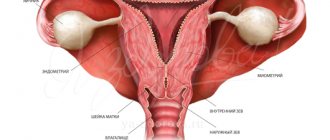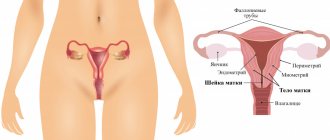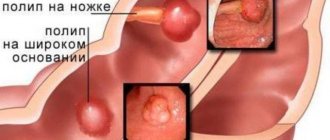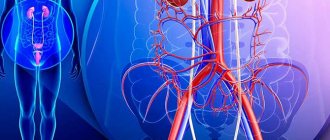Size and growth of the endometrium
The thickness of the uterine lining changes with the phases of the menstrual cycle, since it is a hormone-dependent tissue.
Changes go through the following stages:
- early proliferation - 5–7 days of the cycle, thickness 0.3–0.7 cm;
- average - 11–14 days, 0.5–1 cm;
- late - 15–18 days, 0.7–1.4 cm;
- early secretion - 19–23 days, 1–1.6 cm;
- average - 19–23 days, 1.4 cm;
- late - 24–27 days, 1–1.7 cm.
Changes in a woman’s body associated with fluctuations in hormone concentrations can be classified into three phases:
- Proliferation is the initial phase, lasting the first three days after the end of menstruation. The thickness of the endometrium is 0.2 cm, the structure is homogeneous, single or double layer. After about a week, the layer grows to 0.5 cm, becoming three-layered in structure.
- The middle phase lasts about a week with structural changes.
- Late phase - duration 3-4 days, the endometrial layer increases by 0.2-0.3 cm, before ovulation - by 0.8 cm.
Due to hormonal dependence and abundant blood supply, the thickness of the endometrial layer changes depending on the menstrual cycle. Its greatest thickness (up to 14 mm) is achieved at the time of ovulation, the smallest (up to 5 mm) - after menstruation. The ideal thickness for implantation of the embryo is 7 mm. Often the mucosal layer becomes thinner, being less than 5 mm thick, then they speak of its hypoplasia. About 15% of women suffer from this problem. With a thin layer of the endometrium, pregnancy is unlikely.
A thin layer of the endometrium is said to exist if its thickness is less than half a centimeter. In parallel with this process, the secretory mechanism of the mucous membrane functions, making its function complete by the end of the cycle.
Endometrium by cycle phases
Thickness of the uterine lining during the cycle
Choosing the right diet
When diagnosing diseases associated with the endometrium, a woman’s diet should look like this:
1. Vegetables. Preference should be given to zucchini, beets and carrots. For hyperplasia, it is useful to include broccoli and tomatoes in your diet.
2. Fruits. The priority should not be overseas fruits, but green apples. It is also useful to include strawberries, plums and apricots in the menu. In dried form, it is better to use dried apricots and prunes. Sounded dried fruits allow you to keep the level of estrogen in the body under control.
3. Berries. The most useful product in this case will be sea buckthorn and blackberries. It doesn't hurt to include black or red currants in your diet.
4. Seeds. Sesame and flax are beneficial for the female body because they contain a large amount of fiber.
5. Fish and meat. Your choice should be sardines, mackerel and salmon. Red meat is also good for a woman who is planning to become a mother. The high zinc content in chicken and rabbit meat will help regulate the functioning of the woman’s reproductive system.
6. Mushrooms. It is best to add champignons to vegetable stew, because they contain a large amount of Riboflavin (vitamin B2).
The following products should be prohibited:
1. High calorie dressings. For problems with the endometrium, it is better to eat vegetable salad not with mayonnaise and sour cream, but with vegetable oil.
2. Sweets. With diseases of this kind, women often gain extra pounds. As a result, the endometrium grows more actively.
3. Spices. Their use irritates not only the gastric mucosa, but also the uterus itself.
4. Certain drinks. Carbonated water will not bring any benefit to an inflamed and growing endometrium. You should also minimize your consumption of sweet tea and caffeine.
Causes of thin endometrium
To date, doctors have identified several fundamental factors that affect the thickness of the endometrium.
The main ones include:
- hormonal imbalance;
- pathologies of the endocrine system;
- chronic inflammation of the genitourinary system, promoting the formation of adhesions and scarring of the basal layer;
- PCOS;
- frequent use of medications for emergency contraception (used immediately after unprotected sex);
- surgical manipulations on the uterus that damage the basal layer;
- constant stressful situations;
- depression;
- smoking;
- sudden weight loss due to diet or fasting;
- disturbances in the functioning of the hypothalamic-pituitary system, leading to insufficient production of pituitary hormones, under the influence of which the ovaries produce sex hormones;
- vascular diseases leading to disruption of the blood supply to the uterus and appendages;
- tumors of the pelvic organs, compressing the walls of the uterus.
Generally speaking, the hormone estradiol is responsible for the thickness of the endometrium. If the concentration of this hormone is too low, the lining of the uterus will become thinner. As a rule, gynecologists recommend checking the entire hormonal profile. This gives a more complete picture of the patient's health status. If there are deviations, the doctor will advise ovulation stimulation or hormonal correction.
Another reason for hormonal imbalance that prevents the endometrium from enlarging is the absence or insufficient number of estradiol receptors.
The cause of poor circulation may be low blood flow, as well as pathological changes in the pelvic veins. To confirm the diagnosis, you need to consult a phlebologist. He also prescribes treatment.
Of the surgical interventions, the most significant cause of thin endometrium is frequent curettage and abortion. Damage to the basal layer makes regenerative processes impossible. As a result, the mucous membrane becomes thinner. Anomalies of the uterus include a bicornuate uterus, saddle-shaped, and with septa. In addition, thinning of the endometrium can be observed with fibroids, polyps, and adhesions. Confirm the diagnosis using ultrasound. In controversial and difficult situations, computed tomography or magnetic resonance imaging is recommended. Treatment is surgical or conservative, depending on the situation.
Chronic inflammatory processes in the uterine mucosa can lead to its thinning. As a rule, an accurate diagnosis is made after hysteroscopy with biopsy and pathomorphological examination of the biopsy. Long-term use of oral contraceptives or other sex hormones without a doctor’s recommendation and proper monitoring leads to an imbalance in the hormonal balance in the body and, as a result, thinning of the endometrium. The role of heredity in thin endometrium has not been sufficiently studied. However, some authors argue that it plays an important role.
Changes in the endometrium under the influence of hormones
Symptoms and signs of thin endometrium
Many women do not suspect that they have a thin layer of endometrium, which is due to the non-specificity of the signs of the disease.
If girls have a thin endometrium, then in adolescence they may experience:
- breast underdevelopment;
- narrowed pelvis;
- short stature;
- underdevelopment of the vagina (shorter and narrower than it should be);
- absence or insignificant amount of hair in the pubic area;
- later menarche (after 16 years of age).
In women with thin endometrium, the following symptoms are indicative:
- shortened cycle;
- irregular menstruation;
- scanty periods;
- pain during menstruation;
- discharge of blood clots during menstruation;
- metrorrhagia;
- frigidity;
- decreased or absent fertility;
- frequent miscarriages;
- Pregnancy does not occur with regular unprotected sex.
If the cause of thin endometrium is estrogen deficiency as a result of hormonal imbalance, then the following signs may indirectly indicate the disease: bad mood up to depressive states, irritability, early menopause, insomnia, constant fluctuations in blood pressure, decreased libido. Thin endometrium negatively affects not only the psychosomatic state of a woman, but also her appearance. Thus, problems with the skin appear, elasticity deteriorates, skin turgor decreases, dryness and roughness appear, unhealthy color, hair suffers from excessive dryness and fragility.
Prevention of endometrial hyperplasia
To reduce the risk of developing endometrial hyperplasia, it is recommended to visit an obstetrician-gynecologist annually.
In addition, you should:
- normalize your diet and avoid eating foods that contain dyes and preservatives;
- reduce weight;
- normalize glucose and insulin levels;
- lead a fairly active lifestyle, without overloading yourself with exhausting workouts;
- give up bad habits (in particular, drinking alcohol and smoking);
- select effective means of protection against unwanted pregnancy to avoid abortion. Often women opt for combined oral contraceptives. However, you need to pay attention to the fact that only the attending obstetrician-gynecologist can prescribe them after conducting the necessary examination.
Diagnostics
Diagnosis of thin endometrium is based on three principles:
- interviewing the patient;
- gynecological examination;
- additional examination.
During the interview, the doctor details all complaints, clarifies their nature, time and possible cause of occurrence, and dynamics. This will be followed by a gynecological examination, during which the doctor may identify some causes of thin endometrium, such as underdeveloped uterus or congenital anomalies.
Additional research methods are used:
- flora smears;
- laboratory methods to identify the causative agent of infectious diseases;
- tests to determine the level of hormones in the blood;
- ultrasound examination;
- CT;
- MRI;
- hysteroscopy;
- diagnostic laparoscopy.
Based on the results of additional research methods, the doctor will make a final diagnosis and prescribe treatment.
Symptoms
The main symptoms of uterine endometrial hyperplasia are:
- spotting bloody discharge during menopause
- long periods during which a lot of blood is lost
- menstrual cycle irregularities
- bleeding between periods
- infertility
- severe pain during menstruation
But in many cases the disease is latent, that is, without symptoms. It is discovered during an examination by a gynecologist or during an ultrasound diagnosis, when the patient goes to the doctor with completely different complaints. The disease can lead to cancer and infertility.
Treatment of endometrial thinning
Symptoms of thin endometrium are nonspecific, so the disease is most often detected either when it is impossible to get pregnant, miscarriages, when identifying the causes of late puberty, or during a routine examination.
Thinning of the endometrium, which is caused by many pathological conditions, is detected using the following diagnostic procedures:
- Ultrasound examination of the uterus in different periods of the cycle;
- Ultrasound of the genitourinary organs and thyroid gland;
- clinical and biochemical examination of blood and urine;
- if necessary, MRI of the pituitary gland and/or brain;
- analysis of hormones of the pituitary gland, thyroid gland, sex hormones;
- morphological examination of a biopsy sample taken by biopsy.
The choice of treatment is made taking into account the cause of thin endometrium.
Drug treatment is aimed at combating the cause of the disease:
- in case of infection of the genital organs, antibacterial therapy is prescribed;
- hormonal imbalance is eliminated with the help of hormone-containing drugs, these can be COCs (oral contraceptives);
- when planning pregnancy, thickening of the endometrium is achieved through a course of hormonal therapy. Regular use of hormonal drugs can reduce the muscle tone of the uterus and prevent epithelial rejection;
- if pathology is detected during pregnancy, then treatment with progesterone is carried out, otherwise, the thin endometrium can become a factor in rejection and death of the embryo;
- Placental preparations containing components of a healthy placenta are used as symptomatic therapy. With their help, they normalize the menstrual cycle, alleviate chronic fatigue syndrome, and improve skin condition. These drugs have a range of contraindications, including pregnancy, so there can be no talk of taking them on their own;
- in case of circulatory disorders, drugs are selected that restore microcirculation. The course of treatment is up to 6 weeks. Certain drugs can also be prescribed during gestation after the formation of the placenta has completed.
Treatment for thinned endometrium
Surgery
When the endometrial layer is thinned, the lack of results from drug treatment is an indication for surgical curettage followed by hormone therapy. After radical intervention, in most cases the mucosal layer is renewed and its thickness becomes normal.
Physiotherapy
Physiotherapeutic treatment is prescribed in combination with medication and after surgery during the rehabilitation period. Physiotherapy is not used for cysts, teratomas, hormone-dependent tumors of the gonads, cycle disorders caused by chromosomal mutations, endometriosis, genital tuberculosis in the acute stage, purulent inflammation in the pelvic organs.
The choice of physiotherapeutic method is carried out depending on the causes of the disease, the phase of the menstrual cycle, contraindications, individual reaction, and hormonal conditions. Thus, certain procedures can be performed only with an increased concentration of estrogen, others - with a deficiency of sex hormones. Some methods are used in preparation for IVF (read more about preparing for IVF in this material - note altravita-ivf.ru), as well as during pregnancy, only in the latter case the intensity of the effects is reduced and the duration of the course is shortened.
Thin endometrium is best treated using the following physical procedures:
- Laser therapy is the use of various diodes (depending on the device) that emit red or infrared waves that penetrate the affected tissue to different depths. Laser therapy improves microcirculation, stimulates local immunity, relieves inflammation and vascular spasms, promotes the resorption of scar tissue and healing, and has an analgesic and decongestant effect.
- Magnetotherapy is the action of a magnetic field with different induction on the affected tissue, especially effective after surgical operations. Magnetotherapy has an analgesic, anti-edematous, anti-inflammatory, sedative, and antispasmodic effect. Helps lower blood pressure and blood clotting. The procedure is widely used for gynecological diseases, since it has virtually no contraindications due to the absence of a thermal effect. Magnetic therapy can be prescribed even for fibroids and endometriosis.
- Electrotherapy is the effect of pulsed or direct currents on tissue, allowing to relieve vascular spasm, relax smooth muscles, improve blood supply to the mucous membrane, and relieve pain.
- Ultrasound therapy - ensures blood flow to the affected area, “softens” adhesions due to the thermal effect and micromassage, and promotes the production of estrogen.
- Phototherapy is the use of UV rays that have antibacterial, anti-inflammatory, and analgesic effects.
- Local mud applications - tampons with warm therapeutic mud (39-40 degrees) are placed in the vagina. Course – up to 15 procedures.
- Electrophoresis using biogenic medicinal stimulants. A course of up to 15 procedures.
- Gynecological massage up to 40 procedures and irrigation up to 12 procedures using warm mineral water.
- Abdominal-vaginal massage stimulates tissue metabolism, increases the permeability of cell membranes, improves blood and lymph flow, normalizes tissue trophism, and prevents the formation of adhesions. Course - up to 12 procedures.
Stimulates the production of sex hormones: mud therapy, UV therapy, electrophoresis, paraffin therapy, mineral baths, massage and vibration massage, sanatorium treatment in mountainous areas. Physiotherapy begins approximately on the fifth day of the menstrual cycle, and before ovulation the intensity of the effect is slightly reduced.
Massage to enlarge the endometrium
Nutrition
Proper nutrition is included in the treatment complex. The foods you eat should be rich in retinol (vitamin A) and tocopherol (vitamin E). There are many such vitamins in pumpkin, carrots, dried apricots, cod liver, buckwheat, potatoes, peas, nuts (peanuts, almonds) and other products. The diet should include fish and vegetable dishes, dried fruits, and berries. Oriental spices are useful. Do not consume fast food, baked goods, or fatty foods. You need to drink more clean water, less strong coffee and black tea.
Danger of HGE
Treatment of endometrial hyperplasia should not be delayed. The fact is that, under certain conditions, GPE can become a catalyst for the development of oncological processes.
Another dangerous consequence of the disease is infertility, since pathological changes occurring in the endometrium prevent the embryo from attaching to the wall of the uterus. As HPE progresses, the chances of pregnancy decrease further. In addition, the risk of miscarriage and premature birth increases.
Endometrial hyperplasia is characterized by prolonged menstruation, a significant amount of menstrual flow and intermenstrual bleeding. As a result, patients with HPE are more likely to develop anemia due to constant blood loss.
Sometimes, after treatment, the disease may return. According to statistics, relapses occur on average in 32% of cases after conservative therapy and in 12% of cases after surgery. This is due to repeated hormonal imbalances.










